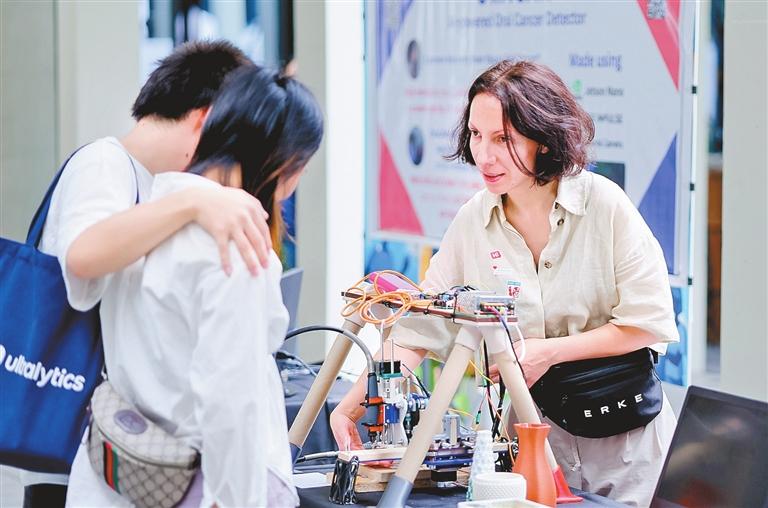
Cao Zhen caozhen0806@126.com FROM an AI-powered detector that spots stray cats under vehicles to a robot-like man wearing a monitor-shaped helmet and an oral cancer detection device powered by AI, Maker Faire Shenzhen 2024 offered no shortage of innovative gadgets and prototypes over the weekend. With the theme “Enchant Everything With AI,” the event — organized by Chaihuo Maker Space in partnership with Seeed Studio, Make Community, and Shenzhen Polytechnic University and co-organized by Vanke Cloud City — brought together over 120 exhibitors from nearly 20 countries and regions. In its 13th year, Maker Faire Shenzhen is widely recognized for connecting markers around the world and showcasing Shenzhen’s identity as a city of innovation. Held at Design Commune in Nanshan District, the event showcased innovations across more than 30 sectors, including AI, robotics, smart manufacturing, education, entertainment, smart cities, and smart agriculture. Exhibitors ranged from well-known firms like NVIDIA, Raspberry Pi, Seeed Studio, and Ultralytics to 18 universities. Paul Kwiatkowski, an American design teacher at the International School of Nanshan Shenzhen, presented gadgets created by himself and his students. Teaching 3D printing and modeling, product design, and rapid prototyping, he hoped to connect with local companies to bring new technologies to his students. Arijit Das, an 18-year-old university freshman from India, presented OraCan, an AI-powered device that detects three common types of oral cancer. Although he hasn’t sought business partners yet, Das plans to enhance the device with a portable 3D-printed enclosure for use in remote areas. “We are interested in meeting some universities and joining in communities for educational project exchanges. We have attended the Maker Faire Moscow for four years, and now we come to Shenzhen to broaden our horizons,” said Anna Vakulik from Fablab Moscow, a digital production lab at Russia’s National University of Science and Technology MISIS. The lab exhibited its computer numerical control (CNC) machine for making printed circuit board (PCB) components, robot kits for students, and 3D-printed clay products. The event also featured inspiring talks, including “The AI-Driven Maker Era” session with Eric Pan, founder of Seeed Studio and Chaihuo Maker Space, and Eric Migicovsky, founder of Pebble and co-founder of Beeper. The “AI for Science” session saw biology and engineering experts from research institutes and companies discuss AI integration in interdisciplinary research. The “AI for Good” session highlighted how AI contributes to the U.N. Sustainable Development Goals. The “Cyber Farms” session showcased how technology enhances productivity and creates new opportunities in rural areas. The fair also included 21 workshops and 11 activities. Some workshops offered hands-on experiences for children in welding, programming, 3D-printed wearables, and basic robotics, while those for professionals covered advanced topics such as perception systems, TinyML, Arduino, and AI models. | 
